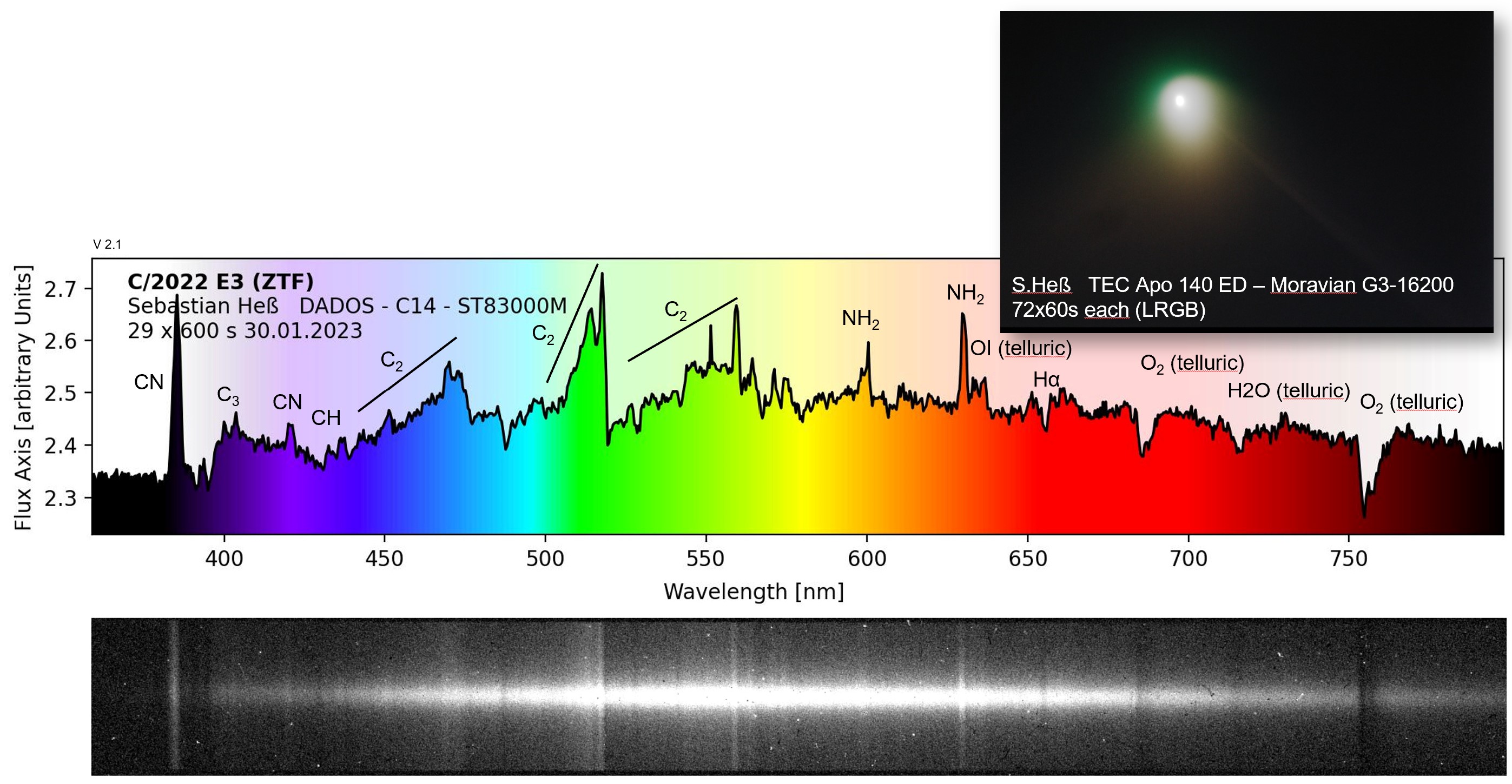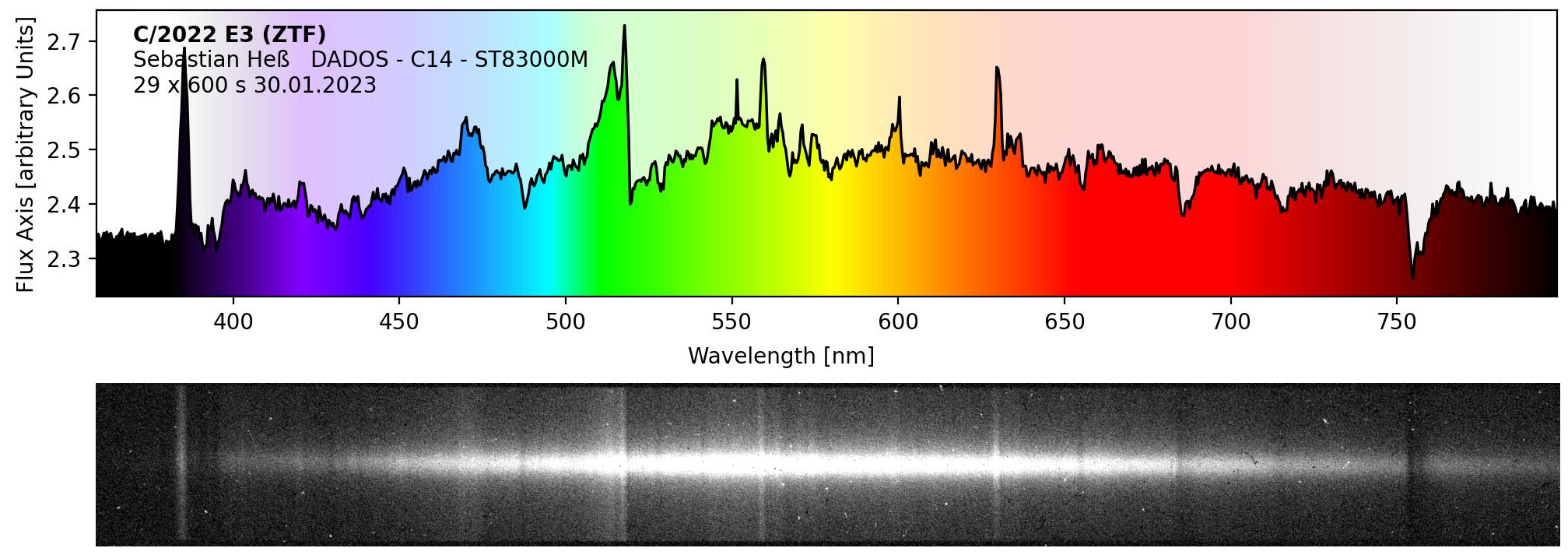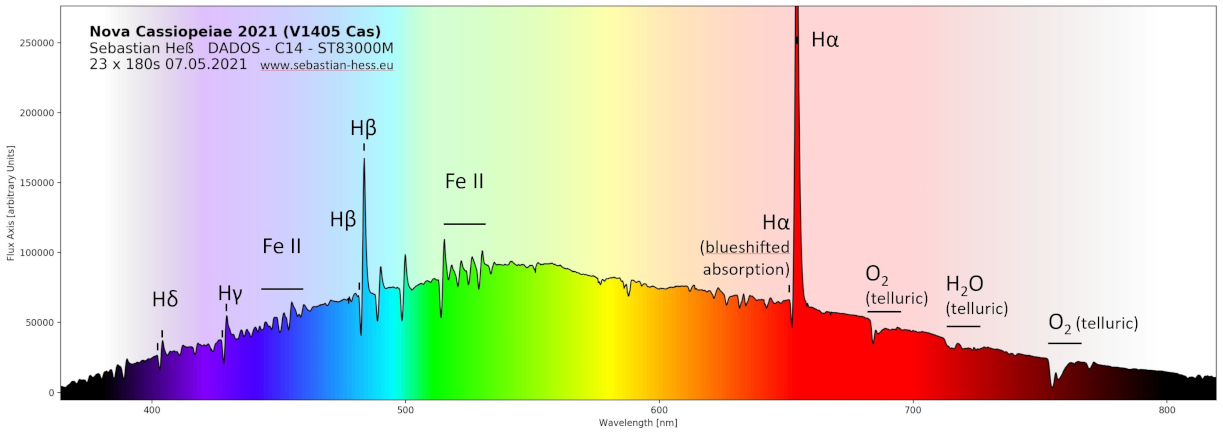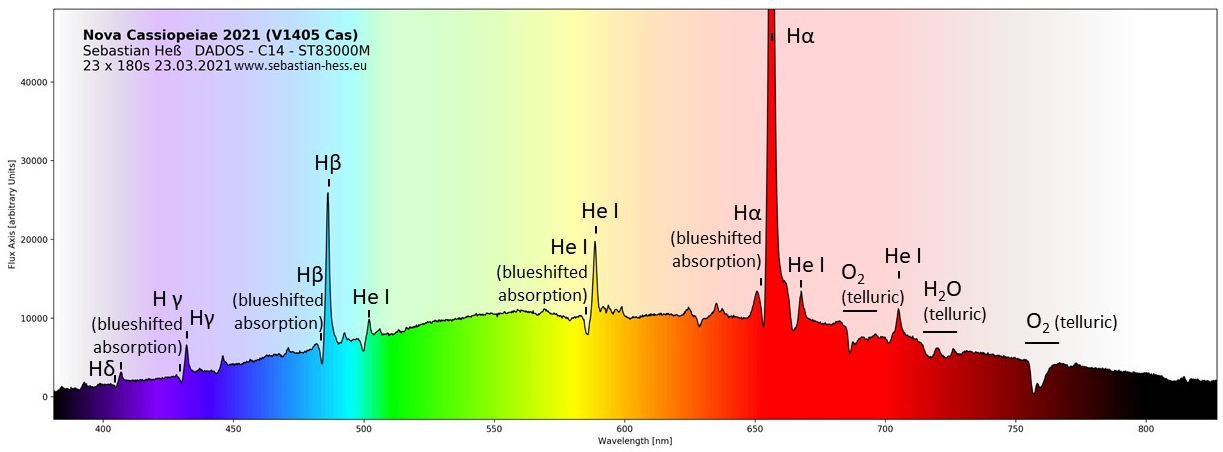
Welcome to my Astrospectroscopy Blog


updated: 17.04.2023
Welcome to my blog on astrophysical spectroscopy. All spectra are taken with the Baader DADOS or BACHES Spectrograph and are presented with some background on the observed objects as well as an insight into the involved physics. This page is a translation from german. I just started with this project, hence I kindly request some patience. Nonetheless, if you want to get more insight into the topics, even if you do not understand german, please feel free to click in the above links which will guide you to the german pages.
February 2023 - Including the bare image of comet C/2022 E3 ZTK
 Despite my focus on the visualization of spectra I let the camera on my TEC run resulting in a nice black/white image of the comet.
Since comet spectra are usually a combiniation of many images and comets usually do have large angular velocity in front
of the sky background, most comet images show long star trails. However, I decided for the usage of a median preprocessing
resulting in an image of the bare comet without stars. Since I am not a big photographer, there will still remain a version
without image ;-) .
Despite my focus on the visualization of spectra I let the camera on my TEC run resulting in a nice black/white image of the comet.
Since comet spectra are usually a combiniation of many images and comets usually do have large angular velocity in front
of the sky background, most comet images show long star trails. However, I decided for the usage of a median preprocessing
resulting in an image of the bare comet without stars. Since I am not a big photographer, there will still remain a version
without image ;-) .
C/2022 E3 (ZTK) - A spectral apporach to the comet
 There are many images of comet ZTK available. Find here a spectrum of comet C/2022 E3 (ZTK) end of january 2023. While the
yellow press gave it the name "green comet" (have there been other colors for comets in the past ? ;-) ), feel free
to have here a glance at the "Swan-bands" which are the true reason for the comet's glowing corona. Swan-bands mainly consist
of carbon monoxide molecular vibrational bands, a compon of many lines, glowing in the green and blue parts of the spectrum.
Good, there is not sufficient oxygen available up there, as carbon dioxide would be barely visible to the eye.
There are many images of comet ZTK available. Find here a spectrum of comet C/2022 E3 (ZTK) end of january 2023. While the
yellow press gave it the name "green comet" (have there been other colors for comets in the past ? ;-) ), feel free
to have here a glance at the "Swan-bands" which are the true reason for the comet's glowing corona. Swan-bands mainly consist
of carbon monoxide molecular vibrational bands, a compon of many lines, glowing in the green and blue parts of the spectrum.
Good, there is not sufficient oxygen available up there, as carbon dioxide would be barely visible to the eye.
October 2022 - Io, Europa, Ganymede and Callisto - Galilean Moons
 Well, it's a pitty, there are not that many differences between the spectra of the galilean moons. Maybe Europa is quiet bright due to
it's shiny and icy surface reflecting a lot of the incoming sunlight. All recognizable lines are from sun's atmosphere selectively
reflected light from the surface of the moons.
Well, it's a pitty, there are not that many differences between the spectra of the galilean moons. Maybe Europa is quiet bright due to
it's shiny and icy surface reflecting a lot of the incoming sunlight. All recognizable lines are from sun's atmosphere selectively
reflected light from the surface of the moons.
September 2022 - BW Vulpeculae - A hot Beta-Cepheid star
 Compared to the much colder Delta-Cepheid stars, Beta-Cepheids are extremely hot stars of spectral class B.
Their pulsation must not be driven by the classical Kappa-process (opacity of helium) but by temperature
and pressure dependency of the opacity of iron.
Compared to the much colder Delta-Cepheid stars, Beta-Cepheids are extremely hot stars of spectral class B.
Their pulsation must not be driven by the classical Kappa-process (opacity of helium) but by temperature
and pressure dependency of the opacity of iron.
April 2022 - Eskimo - Spectrum of a classical Planetary Nebula
 Due to the environmental conditions in planetary nebulae, the dominating emission lines
- the forbidden lines of the double ionized oxygen as well as the single ionized nitrogen - become easily visible.
Due to the environmental conditions in planetary nebulae, the dominating emission lines
- the forbidden lines of the double ionized oxygen as well as the single ionized nitrogen - become easily visible.
January 2022 - T Tauri! The young wild one
 T Tauri Stars are young variable less massive hence relatively yellow or even orange stars just leaving the phase of
creation. They do still possess an accretion disk and lie above the Zero Age Main Sequence Line. Hence they are not
located within the classical variation zones within the Herzsprung - Russel - Diagram, however they show strong
irregular variability. With high resolution spctroscopy it is even possible to visualize the Zeemann effect within
specific lines prooving the existence of strong magnetig fields. The magnetic fields are usually also the origin of strong
jets and stellar winds leading to surrounding nebulae called Herbig - Haro - Objects. In contrast to Planetary Nebulae
those objects are usually less regular in shape and are created at the beginning, not at the end of a star's live.
T Tauri Stars are young variable less massive hence relatively yellow or even orange stars just leaving the phase of
creation. They do still possess an accretion disk and lie above the Zero Age Main Sequence Line. Hence they are not
located within the classical variation zones within the Herzsprung - Russel - Diagram, however they show strong
irregular variability. With high resolution spctroscopy it is even possible to visualize the Zeemann effect within
specific lines prooving the existence of strong magnetig fields. The magnetic fields are usually also the origin of strong
jets and stellar winds leading to surrounding nebulae called Herbig - Haro - Objects. In contrast to Planetary Nebulae
those objects are usually less regular in shape and are created at the beginning, not at the end of a star's live.
December 2021 - alle wetter! Shortest day of the year
 Unexpectedly I had the honour to give an interview on the 20th of december in hessian broadcast television.
Topic was the shortest day of the year. Despite this fact, the day of the latest sunset has happened early in
december and the latest sunrise will happen late in january. This effect is due to the time equation resulting
in the specific shape of the analemma (its similar to an eight). As this effect origins from the combination
of the project of the eclipse as well as the angular speed of earth on its path around the sun. On different
planets, this form is different. E.g. on mars its not an eight, but looks like a raindrop. However in
hires spectroscopy, it is important to correct for those earth-specific characteristics as it changes the
dopplershift of the observed lines. This is e.g. of particular interest in the search for extraterrestrial planets
with the radial velocity method.
Unexpectedly I had the honour to give an interview on the 20th of december in hessian broadcast television.
Topic was the shortest day of the year. Despite this fact, the day of the latest sunset has happened early in
december and the latest sunrise will happen late in january. This effect is due to the time equation resulting
in the specific shape of the analemma (its similar to an eight). As this effect origins from the combination
of the project of the eclipse as well as the angular speed of earth on its path around the sun. On different
planets, this form is different. E.g. on mars its not an eight, but looks like a raindrop. However in
hires spectroscopy, it is important to correct for those earth-specific characteristics as it changes the
dopplershift of the observed lines. This is e.g. of particular interest in the search for extraterrestrial planets
with the radial velocity method.
August 2021 - SS Cyg, a Dwarf Nova
![]() In contrast to classical Novae, powered by thermonuclear explosions on the surface of the white star,
brightness changes of a dwarf nova depend on the variability of the collisional hot spot between matter of
the companion star to the accretion disk around the white dwarf. Hence the observed
spectroscopic features differ a lot from that of classical novae. The spectra showed above were observed
with a periodicity of a few days just after an outburst of SS Cyg, which is - together with U Gem - the
prototype if this class of objects.
In contrast to classical Novae, powered by thermonuclear explosions on the surface of the white star,
brightness changes of a dwarf nova depend on the variability of the collisional hot spot between matter of
the companion star to the accretion disk around the white dwarf. Hence the observed
spectroscopic features differ a lot from that of classical novae. The spectra showed above were observed
with a periodicity of a few days just after an outburst of SS Cyg, which is - together with U Gem - the
prototype if this class of objects.
Mai 2021 - Fe Lines! (V1405 Cas Revisited)
 In mai, the nova became brighter and obviously now there are many more lines. On the other hand, He emission vanished. In th past it seemed,
V1405 Cas belonged to the rare "He/N"-nova subtype (brightest non-balmer type line He or N). However the narrow profiles of the
emission lines as well as the typical P-Cygni Lineprofiles were contraindicatory. But ... hey ... is this Fe II Lines appearing?
Looks like the type of the nova is changing to Fe II Type.
In mai, the nova became brighter and obviously now there are many more lines. On the other hand, He emission vanished. In th past it seemed,
V1405 Cas belonged to the rare "He/N"-nova subtype (brightest non-balmer type line He or N). However the narrow profiles of the
emission lines as well as the typical P-Cygni Lineprofiles were contraindicatory. But ... hey ... is this Fe II Lines appearing?
Looks like the type of the nova is changing to Fe II Type.
March 2021 - Nova Cas 2021 (V1405 Cas)
 Nova Cassiopeiae 2021 - Finally - an easy .. since luminous - nova! End of March we captured a spectrum with our recently commissioned
observatory in spain. Impressively observed: the P Cygni profile as can be recognized often, especially at the beginning.
High velocity material exhausted by the nova leads to a blueshifted absorption line close to each emission line.
Nova Cassiopeiae 2021 - Finally - an easy .. since luminous - nova! End of March we captured a spectrum with our recently commissioned
observatory in spain. Impressively observed: the P Cygni profile as can be recognized often, especially at the beginning.
High velocity material exhausted by the nova leads to a blueshifted absorption line close to each emission line.
January 2021 - Done ... We are online!
 Here we go! After a quiet a long preparation, our remote telescope finally arrived in Spain.
Due to the Corona pandemic in a different way than originally planed by courier service. The integrity of the
Schmidt-plate. bedingt anders als urprünglich geplant, nämlich mit einem Courier-Transportdienst
auf zwei Europaletten. Der Erhalt der „Integrität der Schmidtplatte“ war beim Transport
meiner Ansicht nach der mit Abstand spannenste Part des langjährigen Projektes.
Aber es ist alles gut gegangen und so stehen C14, TEC und DADOS Spektrograph nun als
Remote Teleskop in Spanien. Nach knapp zwei Wochen besten Wetters Mitte Januar sind die ersten
Beobachtungen "im Kasten".
Here we go! After a quiet a long preparation, our remote telescope finally arrived in Spain.
Due to the Corona pandemic in a different way than originally planed by courier service. The integrity of the
Schmidt-plate. bedingt anders als urprünglich geplant, nämlich mit einem Courier-Transportdienst
auf zwei Europaletten. Der Erhalt der „Integrität der Schmidtplatte“ war beim Transport
meiner Ansicht nach der mit Abstand spannenste Part des langjährigen Projektes.
Aber es ist alles gut gegangen und so stehen C14, TEC und DADOS Spektrograph nun als
Remote Teleskop in Spanien. Nach knapp zwei Wochen besten Wetters Mitte Januar sind die ersten
Beobachtungen "im Kasten".
Copyright 2023 Sebastian Hess